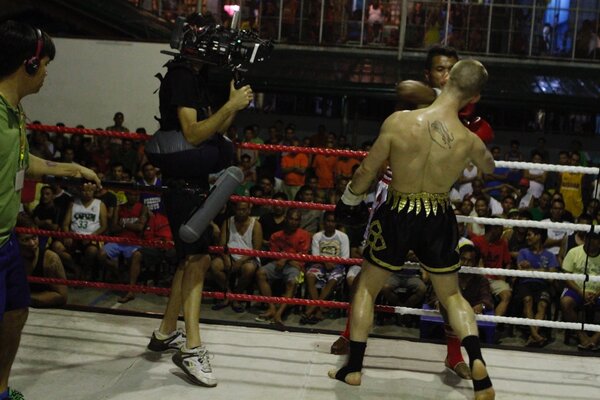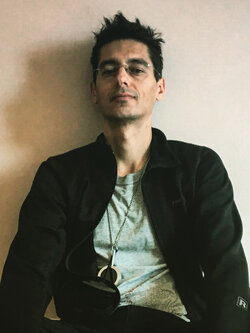Interview with cinematographer David Ungaro, AFC, regarding his work on Jean-Stéphane Sauvaire’s film “A Prayer Before Dawn”
Dancing in the RingAre you familiar with Thai boxing?
David Ungaro: Not at all! But I am familiar with the country as I’ve shot movies there on multiple occasions... For A Prayer Before Dawn, director Jean-Stéphane Sauvaire spent over a year scouting locations, especially to find locations that would be perfect for the story. Personally speaking, I was a latecomer to the project — I replaced another cinematographer who wasn’t available anymore —, and I threw myself wholeheartedly into this very rapid shooting (27 days) that ended up being largely based on the human aspect and on reality. This film was entirely shot on location, abandoned prisons or even working ones, and most of the supporting actors were ex-cons, murderers, drug traffickers, and other felons.

What was the director’s method?
D.U.: Jean-Stéphane has a method that is at the border between documentary and fiction. He relies on a few professional actors for the main roles, and then surrounds himself with a “wild cast” for the rest, which gives shooting a spontaneity that you have to adapt to as a cinematographer. Fitting into that world on set, rehearsing based on the situation described in the screenplay, and then gradually perfecting the shot. No “action!” or “cut!” here!
After a while, we begin shooting, usually with a master shot that lasts for over ten minutes, and we work with the set like a real object in which the film suddenly comes to life. The idea is really to just let things happen... A bit as though it were a deliberate reality.
How did you shoot the movie?
D.U.: It was all about movement. Most of the time, the camera was carried using a gyro-stabilized Stabe One device that I manoeuvred with an exoskeleton. In order to limit the weight of the Stabe One as much as possible, I chose an Arri Alexa Mini. Once outfitted with micromotors, this little camera becomes a very manoeuvrable and light tool. The whole thing weighs hardly more than 7kg, which is a huge difference from 35mm cameras, the lightest of which is nearly 25kg. Most of the film was shot at 1 000 ISO with the Mini, because that’s the sensitivity at which I get the material I like in digital. The camera was set on full aperture at 2 or 2.8, and the Thai assistant camera operator, who was also the focus-puller, was on top of things. Of course, there are a few blurry bits, but that’s part of the energy communicated by the picture and by the film.
No zooms?
D.U.: I don’t like filming with a zoom lens. The contingency of limiting weight logically oriented me towards fixed lenses. I used Zeiss Mark I, which are old but which I like a lot, and they’re especially light and compact. Most all of the film was shot with a combination of 25 and 35mm, with a few tight shots in 50mm. That’s why I often filmed with the lens aimed at the actors’ shoulders, which was a real challenge during the fight scenes. A few shots were also done with the Stabe One mounted on a Western Dolly, regular dolly, or travelling car. This is a technique that is being used more and more often, as it’s a quick way to go from one “set up” to another, while keeping the camera outfitted in the same configuration for the assistants.
What about lighting?
D.U.: The film’s budget was 800,000 Euros. As a cinematographer, when you have that kind of budget, you don’t have much leeway in terms of lighting. Everything was done with three blondes, two red-heads, and a little LED panel. The rest was the result of work with the set designer in order to integrate the light sources into the sets using lighting we got from a home improvement store rather than from a renter of cinema equipment! I really like the desire to stick to reality without stylizing, and the film was made with the mix of lighting characteristic of South-East Asia in mind. A lot of scenes rely on a combination between very cold fluorescent lighting and tungsten bulbs that were sometimes dimmed to 20%, which gave that particular balance between very cold shadows and shining skin.
On A Prayer Before Dawn, there is the night scene in the prison courtyard where you can see the mix between the little halogen bulbs you often find in gardens and very cold mercury light as a counterpoint.
Why did you shoot in the Philippines?
D.U.: The last scene was shot there, in one of the few working prisons that authorize film shoots. This complex is located at Cebu and is run by an ex-con who focuses on prisoner rehabilitation, especially via dance and the arts. Anecdotally, that’s where Michael Jackson filmed his music video “They don’t care about us” in2010, and for the video they organized a giant choreography with the prisoners. We made a few decorative changes, especially to erase the Catholic religious iconography which wasn’t appropriate for Thailand, but besides that, the set jibed perfectly with the rest of the film.
What challenges did you have to face?
D.U.: There were three main challenges in the film that we had to rehearse a lot for. Either the starring role who had to learn the moves, or me at the camera having to find a shared choreography but doing so safely.
From a cinematographic point of view, we first chose a very syncopated and chaotic form for the first fight, which was a moment that focused on instinct; you feel that the character still doesn’t really know how to fight..., each punch is thrown without forethought. These shots were short, numerous, and with a highly-contrasted picture.
The second fight, which takes place outdoors during the daytime, is much brighter, with a clearer feeling of master shots.
The third fight, which takes place at night-time, was by far the most difficult to shoot because we wanted to obtain the level of violence of the first fight while working with master shots like in the second fight... We pushed the actors’ physical limits to the maximum and that’s where things can become unsafe!
Were there any accidents?
D.U.: No, everything went alright... nothing broken, even during the improvised fights in the prisoners’ cells. The professional boxers who played in the film were like machines who would repeat exactly what they were told to do. Their placement with the camera was of unparalleled precision, and the rhythm and amplitude of their movements were perfectly controlled. I enjoyed working with them so much, and also feeling myself part of a choreography in the midst of so much unbridled energy.
(Interview conducted by François Reumont on behalf of the AFC)
 En
En
 Fr
Fr









